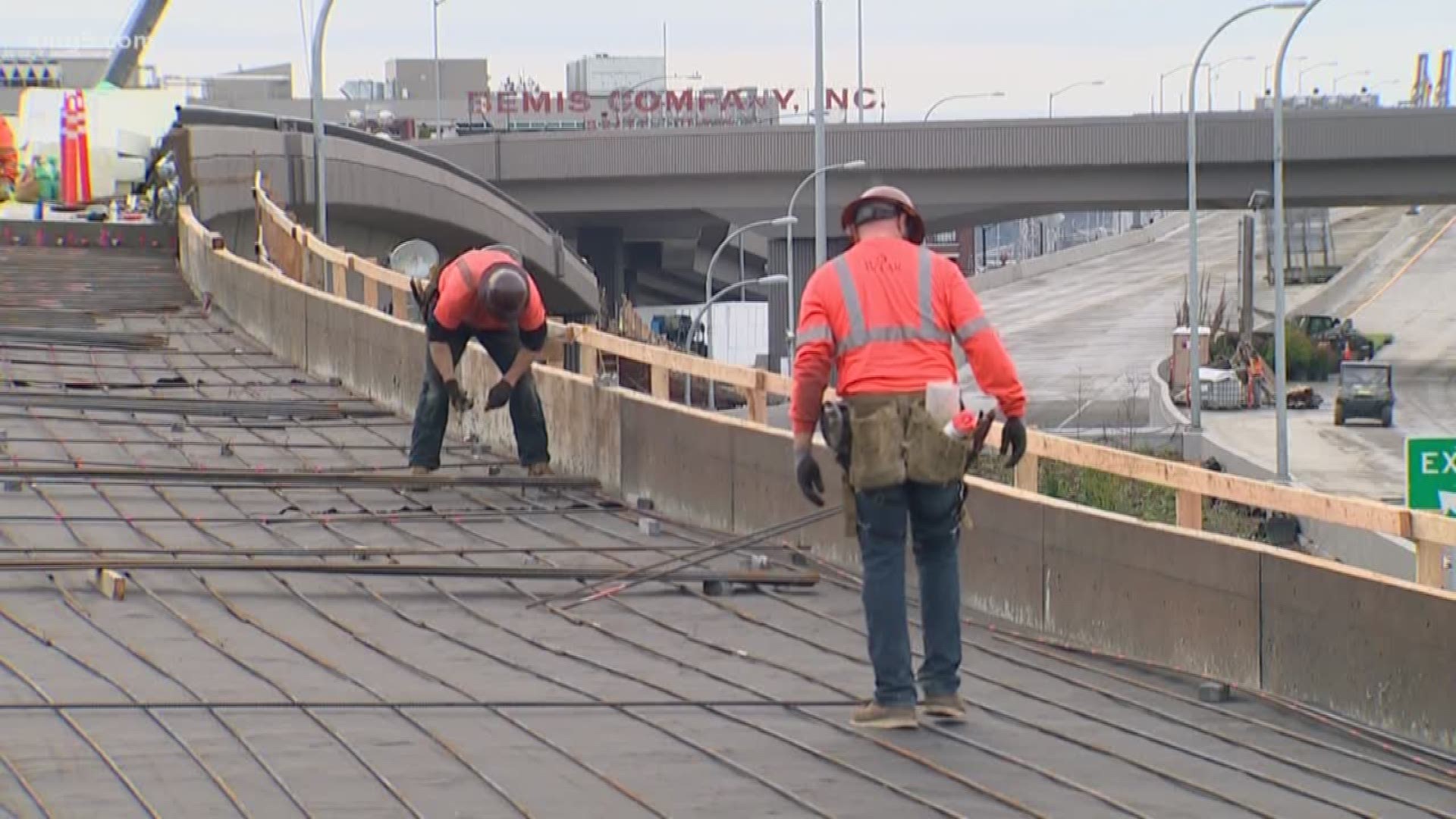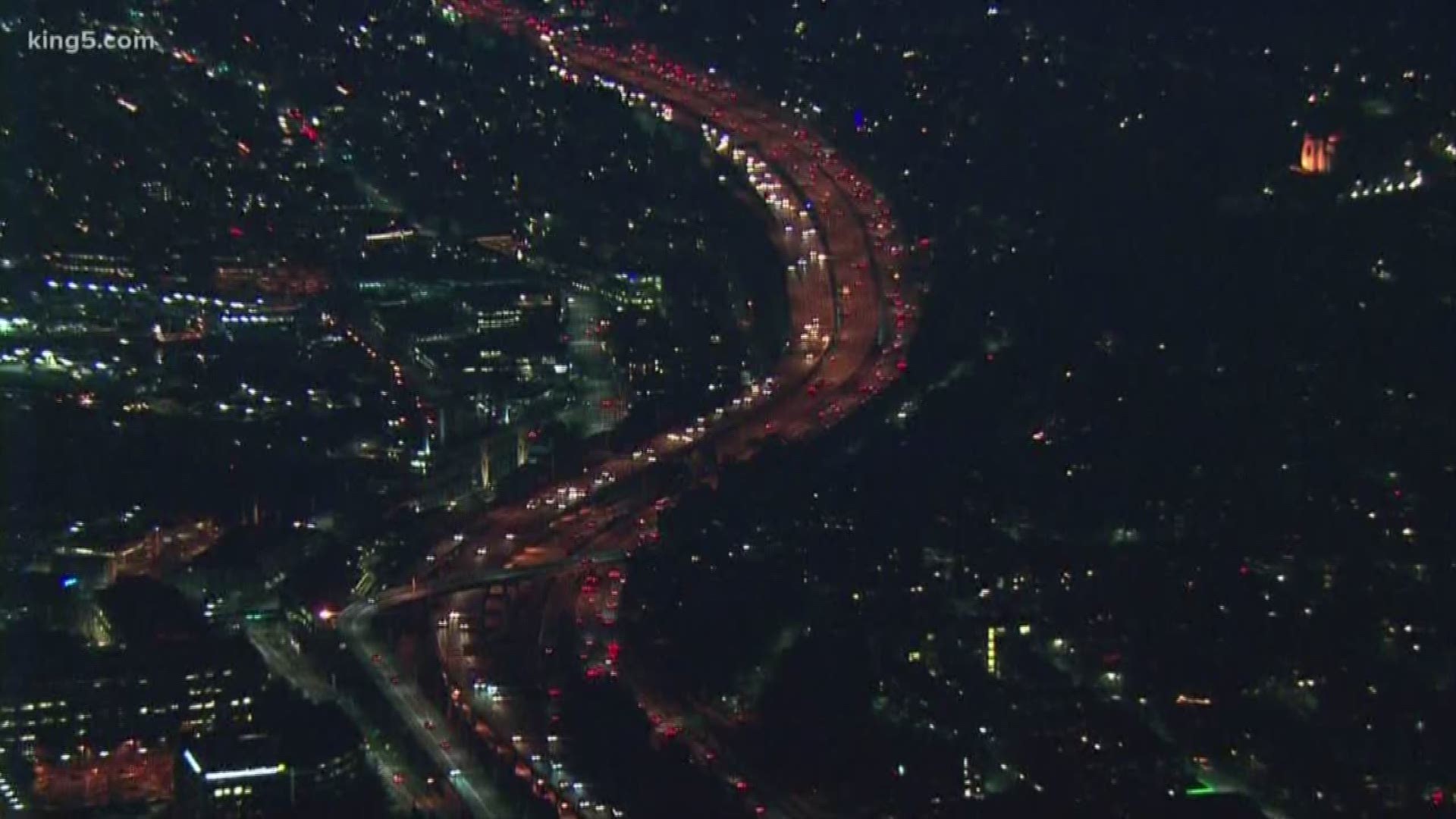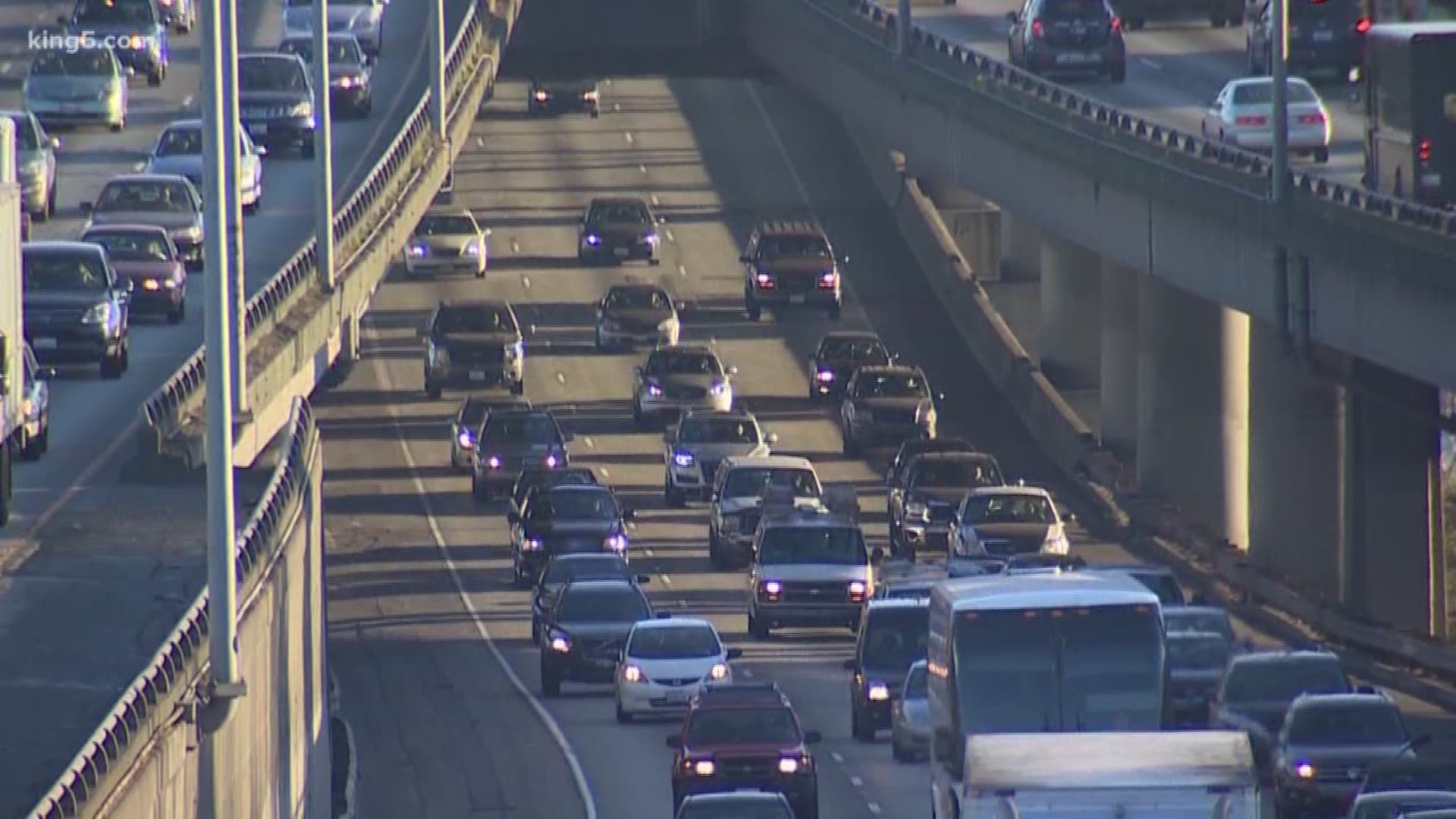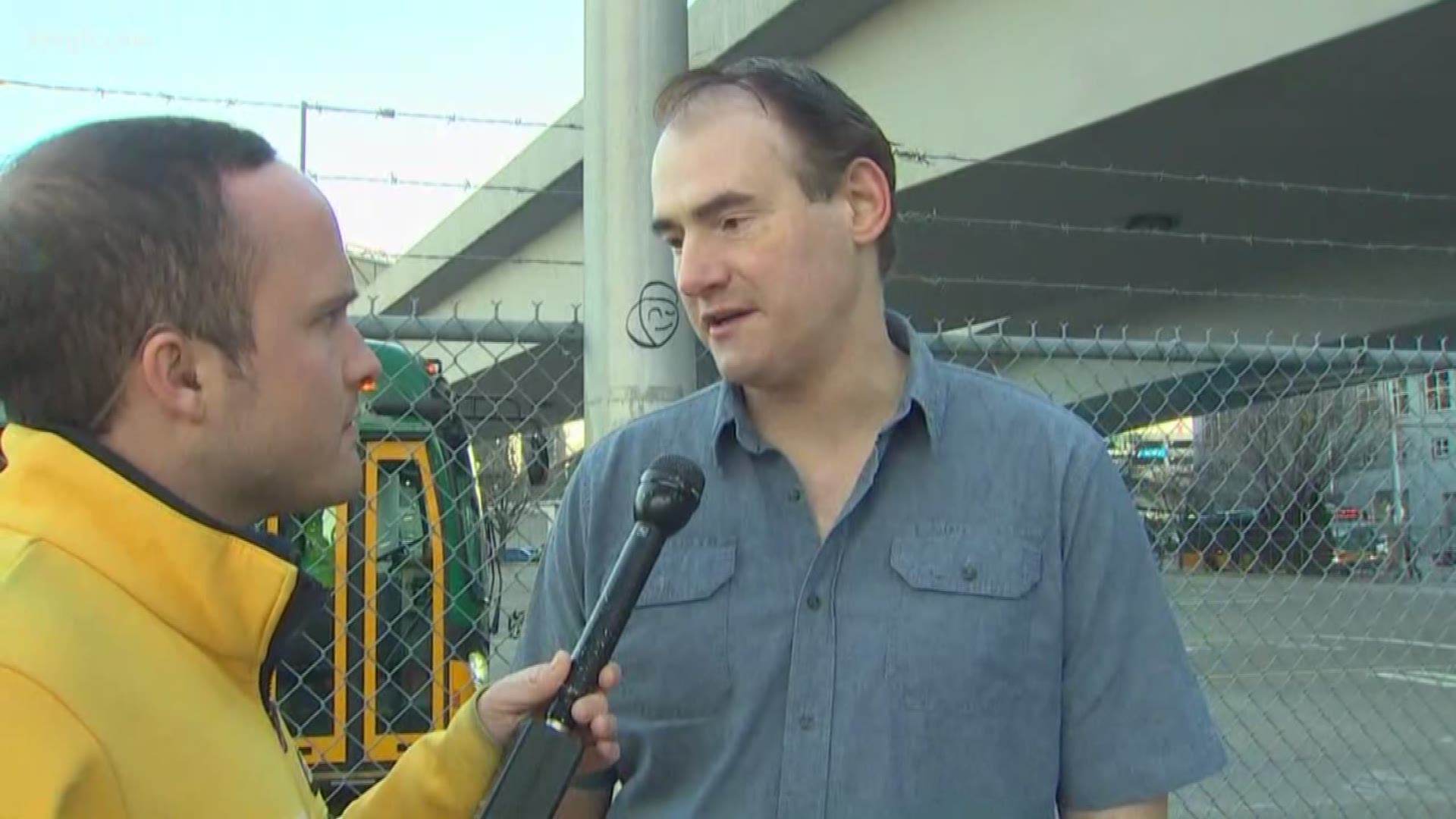Commuters, rejoice. The first week of the "Seattle Squeeze" is over - and it was not the traffic nightmare that many feared. The Alaskan Way Viaduct, which carried 90,000 vehicles every weekday, closed for good on January 11.
The Washington Department of Transportation cautioned commuters to leave early or better yet, come up with a plan to avoid hitting the roads at rush hour.
It appears many commuters heeded the advice and while there were several typical traffic snags throughout the week, no hours-long traffic congestion ever materialized.
Fair weather helped keep additional traffic problems at bay. In fact, this was the warmest start to January on record in Seattle. The conditions also helped crews make 'good progress' on the new SR 99 tunnel under Seattle.
Although rain and winds are settling in for Saturday, weekend traffic should be light as usual, with no other major construction projects underway. Traffic on Monday should also be lighter as Puget Sound celebrates Martin Luther King Jr. Day.
The traffic test starts again Tuesday and last through two more work weeks until the new tunnel under Seattle opens on Feb. 4.
Friday night commute of "Seattle Squeeze" mostly average
The trouble spots started up north heading into downtown Seattle.
As of 7 p.m., the Alderwood to Southcenter commute on I-5 was 52 minutes, which is 17 minutes longer than average.
Everett to Seattle is 48 minutes, which is 12 minutes longer than usual.
Bellevue to Renton is 16 minutes slower than normal at 32 minutes.
Off the freeways, a collision involving a Metro bus blocked one of the southbound lanes of Aurora Ave. at 85th St. in North Seattle, a major thoroughfare this time of night. Use alternate routes to travel south from Shoreline to Seattle.
FRIDAY MORNING COMMUTE SLOWED BY CAR FIRE, CRASHES
The commute Friday morning started with a car fire on northbound I-5 and didn't get any better from there.
By 7 a.m., several main routes were seeing drive times well above average, and traffic on Seattle surface streets began backing up early.
A crash on South Spokane Street at 11th Avenue blocked all lanes for nearly an hour, making for long delays for people trying to get into the city.
The Seattle Department of Transportation reported heavy traffic on northbound I-5 into the city, along with heavy traffic on the West Seattle Bridge, Mercer Street, and First Avenue South in SODO.
The car fire along northbound I-5 in Federal Way was taken care of before 8 a.m., but backups remained. At the peak of the backup, traffic extended six miles, according to WSDOT.
The car fire was caused by a ruptured fuel tank, according to South King Fire.
The Eastside commute wasn't any better, due to a crash involving a bus. The commute from Lynnwood to Bellevue was approximately 70 minutes by 8 a.m. Everett to Bellevue was 81 minutes at 8 a.m.
Rain and wind didn't help.
West Seattle drivers felt pinch of Seattle Squeeze on Thursday
Drive times were slightly slower than average for the Thursday evening commute in most parts of Puget Sound.
However, one major pinch point was leaving West Seattle on Thursday afternoon. Members of the Seattle Tunnel Traffic Facebook group said it was the slowest commute of the week. Check live Seattle Department of Transportation cameras here.
Further south in Burien, a collision involving a Metro bus snarled traffic off of SR 509 at S. 128th St. Police arrested the driver of a pickup truck for suspicion of DUI after the truck hit the bus and then a power pole.
Thursday morning commute hit few snags
The worst traffic delay on I-5 through 7 a.m. Thursday morning wasn't caused by the closure of State Route 99 in Seattle.
Instead, it was an overnight semi-truck crash at State Route 16 in Tacoma that caused frustration for south end drivers. The crash blocked both directions of I-5 for nearly four hours. Crews had it cleared by 6 a.m.
Meanwhile, travel times from Federal Way to Seattle and Everett to Seattle were at or below normal.
The Seattle Department of Transportation reported moderate traffic on I-5 through the city, with light traffic on most major surface streets around 7 a.m. But by 8:30 a.m., SDOT was reporting heavy traffic on I-5 into the city, a 1-mile backup on southbound State Route 99, and heavy to moderate traffic on surface streets.
On Wednesday, officials raised concerns that rain could complicate Thursday's commute in the region. However, it was a relatively dry commute for most.
That same pattern is expected to repeat on Friday, with rain and blustery winds by Friday night.
Commuters have had a relatively easy start to the "Seattle Squeeze," with travel times along many routes at or below average Monday through Wednesday.
Transportation officials caution that Wednesday and Thursday are typically the heaviest traffic days during a normal week. Drivers are urged to stick to a revised commuting plan, leave early, and stay off the roads if possible.
No major issues for Wednesday evening commute
As of 6 p.m. Wednesday, travel times across Puget Sound were mostly average, or only slightly longer than normal.
The drive on 405 from Southcenter to Alderwood was longer than average at 73 minutes. The normal commute on 405 is 57 minutes.
However, that same commute was quicker than average if you take I-5. The current drive time from Southcenter to Alderwood on I-5 is just 44 minutes, down from an average of 54 minutes.
Another rolling slowdown is from Federal Way to Bellevue, which involves I-5 and I-405. The current commute is 36 minutes, up from an average of 30 minutes.
A police pursuit that ended in a crash on I-5 near Northgate is also causing slowdowns in both directions of the interstate while police investigate.
Wednesday morning commute starts early
If there has been one consistency over the first three morning commutes during the "Seattle Squeeze," it is that more drivers are headed to work earlier.
On Wednesday morning, drive times increased earlier than normal. King County Metro is also seeing more riders earlier in the morning.
Drive times along main routes into Seattle remained about average most of the morning as State Route 99 remains closed.
The drive from Everett to Seattle saw an early morning spike in travel times due to two crashes, but it dipped back down to average times. The pair of crashes impacted Community Transit riders, as routes 422, 421, 425, 512, and 532 saw delays.
People driving on Seattle surface streets saw lengthy backups as the morning commute continued. A stalled train didn't help, causing traffic delays around Spokane Street.
The Washington State Department of Transportation said that by 8:30 a.m., only a handful of routes were seeing above-average times.
Tuesday commute brings mostly average drive times
The commute was also hampered by dense fog. The National Weather Service issued a Dense Fog Advisory that was in effect through 9 a.m. Visibility in some areas around Puget Sound was less than a quarter of a mile.
The biggest traffic mess happened as Tuesday's morning commute came to an end. Around 8:45 a.m., a dump truck rolled over on northbound I-5 near Northgate. It blocked several lanes - and at one point all lanes - and created what turned into a 4-mile backup.
The evening commute fared even better. The Washington State Department of Transportation reported that travel times were the same or quicker than average in most areas. Bellevue to Issaquah and Bellevue to Seattle registered slower than average, but only by a few minutes.
Demand for the West Seattle water taxi remained strong on Tuesday with the Ride2 West Seattle shuttles in service. King County Metro deployed standby buses on 51 trips today and carried an estimated 1,700 riders on those buses.
Monday's commute better than expected
Although the first test of the "Seattle Squeeze" went better than expected, commuters were urged Monday not to let down their guard and to remain vigilant with their alternative traffic plan.
"This morning was promising," said Bart Treece, spokesperson for the Washington State Department of Transportation. "We need folks to keep that up."
The evening commute was also hassle-free, aside from low-lying fog around the Sound Sound.
But transportation officials were quick to remind commuters that traffic could get much worse as the week continues. As we headed into the heart of the work week, Treece warned people may have worked from home Monday or were off Monday on a flexible schedule and will commute into work Tuesday, Wednesday, and Thursday.
"Those can be a pretty good telltale sign of how folks are adjusting, and so that’s why we’re cautiously optimistic that people are making those choices, and we’ll hopefully get through that Thursday and see how the commute did," Treece said.
There were minimal delays along Interstate 5 and I-405 during Monday's morning commute. Lisa Van Cise, a spokesperson for WSDOT, said most delays were between 10 and 20 minutes.
Drivers on southbound I-405 saw the worst of it, as travel times from Everett to Bellevue increased 20 minutes. But that was due to a crash.
King County Metro also noted a pinch point for southbound drivers on Aurora Avenue where the roadway goes down to one lane near the Battery Street Tunnel. However, that added congestion was expected due to the lane closure.
Transportation officials also noted traffic built up earlier than normal for the morning and evening commutes. For example, northbound I-5 out of Kent saw travel times increase starting at 5:30 a.m., and they were about 20 minutes longer than normal until 6:15 a.m., which Treece said was unusual.
King County Metro says there were a number of additional people on buses, and the agency deployed 20 extra buses that carried an additional 350 riders, mostly on the 120 route and the RapidRide E Line. Those extra buses were also used for the afternoon commute.
Sound Transit said light rail, Sounder train, and bus passenger traffic was about normal.
However, ridership on the King County Water Taxi tripled compared to this time last year, according to King County Executive Dow Constantine. The water taxi has added an extra vessel during the closure, and capacity was about 50 percent Monday morning, according to Terry White, Metro deputy general manager.
Demand was so high for King County Metro's new shuttle service Ride2 that the agency announced Monday night it was unable to fill all the ride requests by app or phone. Ride2 launched in December to offer on-demand service between the Alaska Junction and the West Seattle water taxi dock.
Transit riders were urged to pad their commutes by 30-60 minutes, and drivers should add 25-30 minutes.
"Last time the Viaduct closed, day two commute was awful. Have a plan and stick to it," WSDOT tweeted Monday.
Seattle Mayor Jenny Durkan said Monday was a good example of how the viaduct closure affects the entire region. She said State Route 167 had some of the heaviest traffic and the most backups of all. She thinks it’s because people were trying to get into Seattle early.
“If people are watching this at home and you live in Bellevue or Renton or Kent, and you think that’s a Seattle problem, it’s not. We’re tied together as a region now," Durkan said.
In 2016, the Alaskan Way Viaduct closed for 10 days. Drivers from Everett down to Tacoma and over on the Eastside all saw travel times increase.
The closure occurred while the now-disassembled tunneling machine Bertha bored a hole under the viaduct. In early May of that year, drivers, on average, spent more time in their vehicles during both morning and afternoon peak commutes (6-9 a.m. and 3-6 p.m.), according to data from the Washington State Department of Transportation.
Those heading westbound from Bellevue to Seattle via I-90 saw a sharp spike in their average morning commute. Ditto for those using the 520 Bridge. Morning commute time to Seattle via I-90 hit nearly 30 minutes in the morning and 35 minutes in the afternoon. The commute was just over 25 minutes in the morning via 520 and nearly 35 minutes in the afternoon.
In general, according to the data, commuter traffic started earlier and lasted longer on all major highways.
Since 2016, Washington state's total population has grown by about 243,500, according to the Office of Financial Management. The rate of growth has been more than 1 percent since 2014. Seattle alone has grown by more than 40,000, according to the state.
Join KING 5's Seattle Tunnel Traffic Facebook group to stay up-to-date on the latest Seattle tunnel and viaduct news and get tips to battle traffic during the three-week viaduct closure in January.




